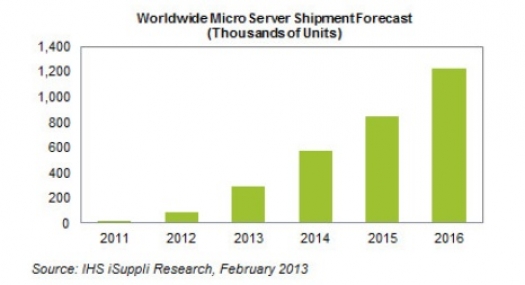IHS: Micro server shipments to treble in 2013

The most aggressive bid for the micro server space is from Intel and ARM
Driven by booming demand for new data centre services for mobile platforms and cloud computing, shipments of micro servers are expected to more than triple this year.
This is according to an IHS iSuppli "Compute Platforms Topical Report" from information and analytics provider IHS.
Shipments this year of micro servers are forecast to reach 291,000 units, up 230 percent from 88,000 units in 2012. Shipments of micro servers commenced in 2011 with just 19,000 units. However, shipments by the end of 2016 will rise to some 1.2 million units, as shown in the figure above.
The penetration of micro servers compared to total server shipments amounted to a miniscule 0.2 percent in 2011. But by 2016, the machines will claim a penetration rate of more than 10 percent, a stunning fifty fold jump.
Micro servers are general-purpose computers, housing single or multiple low-power microprocessors and usually consuming less than 45 watts in a single motherboard. The machines employ shared infrastructure such as power, cooling and cabling with other similar devices, allowing for an extremely dense configuration when micro servers are cascaded together.
"Micro servers provide a solution to the challenge of increasing data-centre usage driven by mobile platforms," says Peter Lin, senior analyst for compute platforms at IHS.
"With cloud computing and data centres in high demand in order to serve more smartphones, tablets and mobile PCs online, specific aspects of server design are becoming increasingly important, including maintenance, expandability, energy efficiency and low cost. Such factors are among the advantages delivered by micro servers compared to higher-end machines like mainframes, supercomputers and enterprise servers - all of which emphasise performance and reliability instead," continues Lin.
Micro servers are not the only type of server that will experience rapid expansion in 2013 and the years to come. Other high-growth segments of the server market are cloud servers, blade servers and virtualisation servers.
Cloud Servers are virtualised servers, often running Windows or Linux operating systems that are instantiated via a web interface or API. Cloud Servers behave in the same manner as physical ones and can be controlled at an administrator or root level, depending on the server type and Cloud Hosting provider.
A blade server is a stripped-down server computer with a modular design optimised to minimise the use of physical space and energy.
The distinction of fastest-growing server segment, however, belongs solely to micro servers.
The compound annual growth rate for micro servers from 2011 to 2016 stands at a remarkable 130 percent - higher than that of the entire server market by a factor of 26. Shipments will rise by double- and even triple-digit percentages for each year during the period.
Key Players Stand to Benefit
Given the dazzling outlook for micro servers, makers with strong product portfolios of the machines will be well-positioned during the next five years - as will their component suppliers and contract manufacturers.
A number of hardware providers are in line to reap benefits, including microprocessor vendors like Intel, ARM and AMD; server original equipment manufacturers such as Dell and Hewlett-Packard; and server original development manufacturers including Taiwanese firms Quanta Computer and Wistron.
Among software providers, the list of potential beneficiaries from the micro server boom extends to Microsoft, Red Hat, Citrix and Oracle. For the group of application or service providers that offer micro servers to the public, entities like Amazon, eBay, Google and Yahoo are foremost.
The most aggressive bid for the micro server space comes from Intel and ARM.
Intel first unveiled the micro server concept and reference design in 2009, ostensibly to block rival ARM from entering the field.
ARM, the leader for many years in the mobile world with smartphone and tablet chips because of the low-power design of its central processing units, has been just as eager to enter the server arena - dominated by x86 chip architecture from the likes of Intel and a third chip player, AMD. ARM faces an uphill battle, as the majority of server software is written for x86 architecture. Shifting from x86 to ARM will also be difficult for legacy products.
ARM, however, is gaining greater support from software and OS vendors, which could potentially put pressure on Intel in the coming years.
































